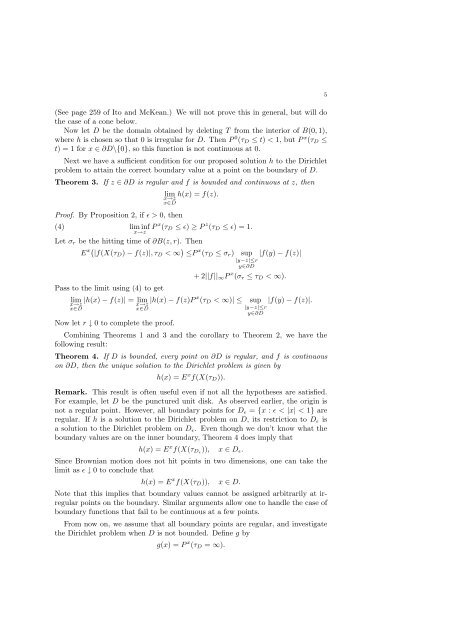Brownian Motion and the Dirichlet Problem - UCLA Department of ...
Brownian Motion and the Dirichlet Problem - UCLA Department of ...
Brownian Motion and the Dirichlet Problem - UCLA Department of ...
You also want an ePaper? Increase the reach of your titles
YUMPU automatically turns print PDFs into web optimized ePapers that Google loves.
(See page 259 <strong>of</strong> Ito <strong>and</strong> McKean.) We will not prove this in general, but will do<br />
<strong>the</strong> case <strong>of</strong> a cone below.<br />
Now let D be <strong>the</strong> domain obtained by deleting T from <strong>the</strong> interior <strong>of</strong> B(0, 1),<br />
where h is chosen so that 0 is irregular for D. Then P 0 (τD ≤ t) < 1, but P x (τD ≤<br />
t) = 1 for x ∈ ∂D\{0}, so this function is not continuous at 0.<br />
Next we have a sufficient condition for our proposed solution h to <strong>the</strong> <strong>Dirichlet</strong><br />
problem to attain <strong>the</strong> correct boundary value at a point on <strong>the</strong> boundary <strong>of</strong> D.<br />
Theorem 3. If z ∈ ∂D is regular <strong>and</strong> f is bounded <strong>and</strong> continuous at z, <strong>the</strong>n<br />
lim h(x) = f(z).<br />
x→z<br />
x∈D<br />
Pro<strong>of</strong>. By Proposition 2, if ǫ > 0, <strong>the</strong>n<br />
(4) liminf<br />
x→z P x (τD ≤ ǫ) ≥ P z (τD ≤ ǫ) = 1.<br />
Let σr be <strong>the</strong> hitting time <strong>of</strong> ∂B(z, r). Then<br />
E x |f(X(τD) − f(z)|, τD < ∞ ≤P x (τD ≤ σr) sup<br />
Pass to <strong>the</strong> limit using (4) to get<br />
|y−z|≤r<br />
y∈∂D<br />
|f(y) − f(z)|<br />
+ 2||f||∞P x (σr ≤ τD < ∞).<br />
lim |h(x) − f(z)| = lim |h(x) − f(z)P x (τD < ∞)| ≤ sup<br />
x→z<br />
x∈D<br />
x→z<br />
x∈D<br />
Now let r ↓ 0 to complete <strong>the</strong> pro<strong>of</strong>.<br />
|y−z|≤r<br />
y∈∂D<br />
|f(y) − f(z)|.<br />
Combining Theorems 1 <strong>and</strong> 3 <strong>and</strong> <strong>the</strong> corollary to Theorem 2, we have <strong>the</strong><br />
following result:<br />
Theorem 4. If D is bounded, every point on ∂D is regular, <strong>and</strong> f is continuous<br />
on ∂D, <strong>the</strong>n <strong>the</strong> unique solution to <strong>the</strong> <strong>Dirichlet</strong> problem is given by<br />
h(x) = E x f(X(τD)).<br />
Remark. This result is <strong>of</strong>ten useful even if not all <strong>the</strong> hypo<strong>the</strong>ses are satisfied.<br />
For example, let D be <strong>the</strong> punctured unit disk. As observed earlier, <strong>the</strong> origin is<br />
not a regular point. However, all boundary points for Dǫ = {x : ǫ < |x| < 1} are<br />
regular. If h is a solution to <strong>the</strong> <strong>Dirichlet</strong> problem on D, its restriction to Dǫ is<br />
a solution to <strong>the</strong> <strong>Dirichlet</strong> problem on Dǫ. Even though we don’t know what <strong>the</strong><br />
boundary values are on <strong>the</strong> inner boundary, Theorem 4 does imply that<br />
h(x) = E x f(X(τDǫ)), x ∈ Dǫ.<br />
Since <strong>Brownian</strong> motion does not hit points in two dimensions, one can take <strong>the</strong><br />
limit as ǫ ↓ 0 to conclude that<br />
h(x) = E x f(X(τD)), x ∈ D.<br />
Note that this implies that boundary values cannot be assigned arbitrarily at irregular<br />
points on <strong>the</strong> boundary. Similar arguments allow one to h<strong>and</strong>le <strong>the</strong> case <strong>of</strong><br />
boundary functions that fail to be continuous at a few points.<br />
From now on, we assume that all boundary points are regular, <strong>and</strong> investigate<br />
<strong>the</strong> <strong>Dirichlet</strong> problem when D is not bounded. Define g by<br />
g(x) = P x (τD = ∞).<br />
5
















